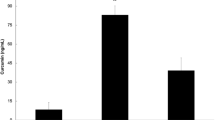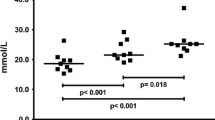Abstract
Activities of enzymes involved in muscle damage [creatine kinase (CK) and aspartate aminotransferase (AST)] and levels of malondialdehyde (MDA) as a marker of oxidative stress were monitored in the plasma of 27 members of an America’s Cup yachting crew. The preventive benefits of allopurinol on muscle damage were also tested. In racing period A, the crew was divided into two groups according to their tasks on board. Blood samples from all 27 sailors were obtained before the start of a 5-day fleet race, after the last race, and after the ten match races. In period B, crew members were divided at random into two groups. One group (13 participants) received 300 mg/day of allopurinol 3 h before racing. The other ten members received placebo. Blood samples were collected just before and after the second round of the Louis Vuitton Cup. All participants showed increased CK and AST activities after the racing period A. The increase in CK activity was highest in sailors involved in strenuous physical work. At the end of period A, plasma MDA levels were higher in all participants as compared with non-participant athletes. In period B, a significant decrease in CK activity, but not in AST, appeared among participants receiving allopurinol. Plasma MDA decreased in sailors treated with allopurinol, but this reduction did not reach statistical significance. America’s Cup is a sailing sport with high physical demands, as shown by the increase in muscle-damage markers. Treatment with allopurinol appeared to decrease the levels of muscle damage markers.






Similar content being viewed by others
References
Allen J (2005) Sports medicine injuries in the America’s Cup 2000. Sports Med 33:43–46
Allen JB, De Jong MR (2006) Sailing and sports medicine: a literature review. Br J Sports Med 40:587–593
Bolgiano EB (1994) Acute rhabdomyolysis due to body building exercise Report of a case. J Sports Med Phys Fit 34:76–78
Brancaccio P, Mafully N, Limongelli FM (2007) Creatine kinase monitoring in sport medicine. British Med Bull 81–82:209–230
Brancaccio P, Lippi G, Maffulli N (2010) Biochemical markers of muscular damage. Clin Chem Lab Med 48:757–767
Clark JF (1997) Creatine and phosphocreatine: a review of their use in exercise and sport. J Athl Train 32:45–51
Clarkson PM (2006) Case report of exertional rhabdomyolysis in a 12-year-old boy. Med Sci Sports Exerc 38:197–200
Clarkson PM, Nosaka K, Braun B (1992) Muscle function after exercise-induced muscle damage and rapid adaptation. Med Sci Sports Exerc 24:512–520
Clarkson PM, Kearns AK, Rouzier P, Rubin R, Thompson PD (2006) Serum creatine kinase levels and renal function measures in exertional muscle damage. Med Sci Sports Exerc 38:623–627
Davies KJ, Quintanilha AT, Brooks GA, Packer L (1982) Free radicals and tissue damage produced by exercise. Biochem Biophys Res Commun 107:1198–1205
Duarte JA, Appell HJ, Carvalho F, Bastos ML, Soares JM (1993) Endothelium-derived oxidative stress may contribute to exercise-induced muscle damage. Int J Sports Med 14:440–443
Ehlers GG, Ball TE, Liston L (2002) Creatine kinase levels are elevated during 2-a-day practices in collegiate football players. J Athl Train 37:151–156
Evans WJ, Meredith CN, Cannon JG, Dinarello CA, Frontera WR, Hughes VA, Jones BH, Knuttgen HG (1986) Metabolic changes following eccentric exercise in trained and untrained men. J Appl Physiol 61:1864–1868
Gomez-Cabrera MC, Pallardo FV, Sastre J, Vina J, Garcia-del-Moral L (2003) Allopurinol and markers of muscle damage among participants in the Tour de France. JAMA 289:2503–2504
Gomez-Cabrera MC, Borrás C, Pallardó FV, Sastre J, Ji LL, Viña J (2005) Decreasing xanthine oxidase-mediated oxidative stress prevents useful cellular adaptations to exercise in rats. J Physiol 567(Pt 1):113–120
Gomez-Cabrera MC, Martinez A, Santangelo G, Pallardo FV, Sastre J, Vina J (2006) Oxidative stress in marathon runners: interest of antioxidant supplementation. Br J Nutr 96(Suppl 1):S31–S33
Gomez-Cabrera MC, Domenech E, Vina J (2008) Moderate exercise is an antioxidant: upregulation of antioxidant genes by training. Free Radic Biol Med 44:126–131
Hadala M, Barrios C (2009a) Different strategies for sports injury prevention in an America’s Cup yachting crew. Med Sci Sports Exerc 41:1587–1596
Hadala M, Barrios C (2009b) Sports injuries in an America’s Cup yachting crew: a 4-year epidemiological study covering the 2007 challenge. J Sports Sci 27:711–717
Hadala M, Cebolla A, Baños R, Barrios C (2010) Mood Profile of an America’s Cup team: relationship with muscle damage and injuries. Med Sci Sports Exerc 42:1403–1408
Hellsten Y, Hansson HA, Johnson L, Frandsen U, Sjodin B (1996) Increased expression of xanthine oxidase and insulin-like growth factor I (IGF-I) immunoreactivity in skeletal muscle after strenuous exercise in humans. Acta Physiol Scand 157:191–197
Heunks LM, Vina J, van Herwaarden CL, Folgering HT, Gimeno A, Dekhuijzen PN (1999) Xanthine oxidase is involved in exercise-induced oxidative stress in chronic obstructive pulmonary disease. Am J Physiol 277:R1697–R1704
Hoffman JR, Maresh CM, Newton RU, Rubin MR, French DN, Volek JS, Sutherland J, Robertson M, Gomez AL, Ratamess NA, Kang J, Kraemer WJ (2002) Performance, biochemical, and endocrine changes during a competitive football game. Med Sci Sports Exerc 34:1845–1853
Kim HJ, Lee YH, Kim CK (2009) Changes in serum cartilage oligomeric matrix protein (COMP), plasma CPK and plasma hs-CRP in relation to running distance in a marathon (42.195 km) and an ultra-marathon (200 km) race. Eur J Appl Physiol 105:765–770
Knez WL, Jenkins DG, Coombes JS (2007) Oxidative stress in half and full ironman triathletes. Med Sci Sports Exerc 39:283–288
Lambert YLC (2001) Medical controls and preparation of the french team for the America’s Cup (1999–2000) (in French). Sci Sports 16:95–99
Lippi G, Schena F, Salvagno GL, Montagnana M, Gelati M, Tarperi C, Banfi G, Guidi GC (2008) Acute variation of biochemical markers of muscle damage following a 21-km, half-marathon run. Scand J Clin Lab Invest 68:667–672
Malm C, Sjodin TL, Sjoberg B et al (2004) Leukocytes, cytokines, growth factors and hormones in human skeletal muscle and blood after uphill or downhill running. J Physiol 556:983–1000
Mougios V (2007) Reference intervals for serum creatine kinase in athletes. Br J Sports Med 41:674–678
Nathwani RA, Pais S, Reynolds TB, Kaplowitz N (2005) Serum alanine aminotransferase in skeletal muscle diseases. Hepatology 41:380–382
Neubauer O, König D, Wagner KH (2008) Recovery after an Ironman triathlon: sustained inflammatory responses and muscular stress. Eur J Appl Physiol 104:417–426
Neville VJ, Molloy J, Brooks JH, Speedy DB, Atkinson G (2006) Epidemiology of injuries and illnesses in America’s Cup yacht racing. Br J Sports Med 40:304–311
Neville V, Calefato J, Pérez-Encinas C, Rodilla-Sala E, Rada-Ruiz S, Dorochenko P, Folland JP (2009) America’s Cup yacht racing: race analysis and physical characteristics of the athletes. J Sports Sci 27:915–923
Nie J, Tong TK, George K, Fu FH, Lin H, Shi Q (2010) Resting and post-exercise serum biomarkers of cardiac and skeletal muscle damage in adolescent runners. Scand J Med Sci Sports (Epub ahead of print March 10)
Nikolaidis MG, Protosygellou MD, Petridou A, Tsalis G, Tsigilis N, Mougios V (2003) Hematologic and biochemical profile of juvenile and adult athletes of both sexes: implications for clinical evaluation. Int J Sports Med 24:506–511
Noakes TD (1987) Effect of exercise on serum enzyme activities in humans. Sports Med 4:245–267
Nosaka K, Newton M, Sacco P (2002) Muscle damage and soreness after endurance exercise of the elbow flexors. Med Sci Sports Exerc 34:920–927
Paschalis V, Koutedakis Y, Baltzopoulos V, Mougios V, Jamurtas AZ, Giakas G (2005) Short vs long length of rectus femoris during eccentric exercise in relation to muscle damage in healthy males. Clin Biomech (Bristol, Avon) 20:617–622
Patel DR, Gyamfi R, Torres A (2009) Exertional rhabdomyolysis and acute kidney injury. Phys Sportsmed 37:71–79
Radak Z, Asano K, Inoue M, Kizaki T, Oh-Ishi S, Suzuki K, Taniguchi N, Ohno H (1995) Superoxide dismutase derivative reduces oxidative damage in skeletal muscle of rats during exhaustive exercise. J Appl Physiol 79:129–135
Richard MJ, Guiraud P, Meo J, Favier A (1992) High-performance liquid chromatographic separation of malondialdehyde–thiobarbituric acid adduct in biological materials (plasma and human cells) using a commercially available reagent. J Chromatogr 577:9–18
Sahlin K, Ekberg K, Cizinsky S (1991) Changes in plasma hypoxanthine and free radical markers during exercise in man. Acta Physiol Scand 142:275–281
Sastre J, Asensi M, Gasco E, Pallardo FV, Ferrero JA, Furukawa T, Vina J (1992) Exhaustive physical exercise causes oxidation of glutathione status in blood: prevention by antioxidant administration. Am J Physiol 263:R992–R995
Stupka N, Tarnopolsky MA, Yardley NJ, Phillips SM (2001) Cellular adaptation to repeated eccentric exercise-induced muscle damage. J Appl Physiol 91:1669–1678
Tokmakidis SP, Kokkinidis EA, Smilios I, Douda H (2003) The effects of ibuprofen on delayed muscle soreness and muscular performance after eccentric exercise. J Strength Cond Res 17:53–59
Veskoukis AS, Nikolaidis MG, Kyparos A, Kokkinos D, Nepka C, Barbanis S, Kouretas D (2008) Effects of xanthine oxidase inhibition on oxidative stress and swimming performance in rats. Appl Physiol Nutr Metab 33:1140–1154
Viña J, Gimeno A, Sastre J, Desco C, Asensi M, Pallardo FV, Cuesta A, Ferrero JA, Terada LS, Repine JE (2000a) Mechanism of free radical production in exhaustive exercise in humans and rats; role of xanthine oxidase and protection by allopurinol. IUBMB Life 49:539–544
Viña J, Gomez-Cabrera MC, Lloret A, Marquez R, Minana JB, Pallardo FV, Sastre J (2000b) Free radicals in exhaustive physical exercise: mechanism of production, and protection by antioxidants. IUBMB Life 50:271–277
Acknowledgments
This work was supported in part by funds from Ministerio de Ciencia e Innovación (SAF 2007-66801), Coopernicus-Santander Program of the Universidad CEU-Cardenal Herrera.
Author information
Authors and Affiliations
Corresponding author
Additional information
Communicated by Martin Flueck.
Rights and permissions
About this article
Cite this article
Barrios, C., Hadala, M., Almansa, I. et al. Metabolic muscle damage and oxidative stress markers in an America’s Cup yachting crew. Eur J Appl Physiol 111, 1341–1350 (2011). https://doi.org/10.1007/s00421-010-1762-6
Accepted:
Published:
Issue Date:
DOI: https://doi.org/10.1007/s00421-010-1762-6




